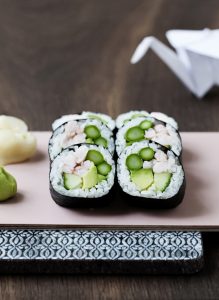
In Denmark, most sushi restaurants use topping on the food. It is typically sushi rolls such as insite-out which are topped with various ingredients such as roe, seaweed salad, chili mayonnaise, pickled onions and crushed wasabi peas. Sushi rolls are often topped in many different ways.
In Japan, topping is not used in the same way as in Denmark.
The Japanese are very fond of fish of very high quality. They eat as much fish as we eat meat.
So that’s why Japanese customers and Japanese sushi chefs have a slightly different approach to sushi. The sushi pieces should preferably be as simple as possible, ie. with rice and fish are in the center so they are allowed to shine.
Sushi topping is used in Japan. It can be lemon, an herb or a specific type of salt, which is used to highlight fish unique flavors and aromas.
At the Sushi course for beginners, you will learn how to make tasty sushi like Japanese sushi chefs in Tokyo.
_
Zoë has lectured and held sushi courses for A. P. Moller – Maersk, Hugo Boss Nordic, Novo Nordisk, Novartis, Velux, Gorrissen Federspiel, Beierholm revision, Elbek & Vejrup and many more.




